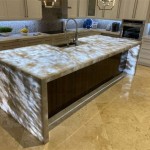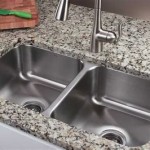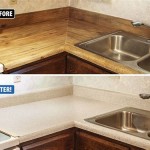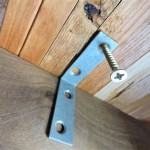Cleaning and Maintaining a Butcher Block Countertop
Butcher block countertops offer a warm, natural aesthetic to any kitchen. Their durable surface is ideal for food preparation, but proper cleaning and maintenance are crucial to ensure longevity and prevent the growth of harmful bacteria. This article provides a comprehensive guide to effectively clean and maintain a butcher block countertop, preserving its beauty and functionality for years to come.
Butcher block is typically constructed from hardwoods such as maple, walnut, cherry, or birch. The close grain of these woods, combined with the end-grain orientation in many butcher block constructions, provides a resilient surface for chopping and cutting. However, wood is porous, making it susceptible to absorbing liquids and harboring bacteria if not properly cared for. A consistent cleaning routine and regular oiling are essential to mitigate these risks.
Daily Cleaning Routine
A consistent daily cleaning routine is the cornerstone of maintaining a hygienic and visually appealing butcher block countertop. After each use, the counter should be promptly cleaned to prevent food residue from drying and becoming difficult to remove. This also helps prevent the growth of bacteria and the absorption of stains. The following steps outline an effective daily cleaning procedure:
1. Remove Food Debris: Begin by scraping away any loose food particles or debris with a bench scraper or a stiff-bristled brush. Ensure that all surfaces, including edges and corners, are cleared of any visible food matter.
2. Wash with Mild Soap and Water: Prepare a solution of warm water and a mild dish soap. Avoid using harsh detergents or abrasive cleansers, as these can damage the wood and strip away its natural oils. A pH-neutral dish soap is generally recommended.
3. Apply the Solution: Dampen a soft cloth or sponge with the soap solution and gently scrub the entire surface of the butcher block. Pay particular attention to areas that have come into contact with food, especially raw meat or poultry.
4. Rinse Thoroughly: After washing, rinse the countertop thoroughly with clean, warm water. Ensure that all traces of soap are removed, as residual soap can attract dirt and grime.
5. Dry Immediately: This is a critical step. Wood absorbs moisture rapidly, and prolonged exposure to water can lead to warping, cracking, or the growth of mold and mildew. Use a clean, dry towel to thoroughly dry the entire surface of the butcher block, including the edges and underside.
6. Air Dry: After towel drying, allow the countertop to air dry completely before placing any items on it. This ensures that any remaining moisture evaporates, further preventing the development of mold or mildew. Allowing good air circulation around the butcher block is vital.
For particularly sticky or stubborn food residue, a slightly more abrasive approach may be necessary. However, it is crucial to avoid excessive scrubbing or the use of harsh abrasives. A paste made from baking soda and water can be gently applied to the affected area and allowed to sit for a few minutes before being scrubbed lightly and rinsed thoroughly.
Deep Cleaning and Sanitizing
While daily cleaning is essential, butcher block countertops also require periodic deep cleaning and sanitizing to eliminate accumulated bacteria and address stains. The frequency of deep cleaning will depend on the countertop's usage, but generally, a thorough cleaning every few weeks is recommended. Several methods can be employed for deep cleaning and sanitizing, each with its own set of advantages and considerations:
1. Lemon and Salt Scrub: This natural method utilizes the antibacterial properties of lemon juice and the abrasive qualities of salt to effectively clean and disinfect the butcher block. Cut a lemon in half and sprinkle coarse salt over the surface of the countertop. Use the cut side of the lemon to scrub the salt into the wood, working in a circular motion. Allow the mixture to sit for approximately 5-10 minutes before rinsing thoroughly with warm water and drying completely. This is a good option for removing light stains and odors.
2. Hydrogen Peroxide: Hydrogen peroxide is a mild disinfectant that can be used to sanitize a butcher block countertop. Dilute 3% hydrogen peroxide with an equal amount of water and spray the solution onto the surface. Allow it to sit for a few minutes before wiping it off with a clean cloth. Rinse thoroughly with warm water and dry completely. Hydrogen peroxide can have a slight bleaching effect, so it's recommended to test it on an inconspicuous area first.
3. Vinegar Solution: White vinegar is another effective natural cleaner and disinfectant. Mix equal parts white vinegar and water in a spray bottle and spray the solution onto the surface of the butcher block. Allow it to sit for a few minutes before wiping it off with a clean cloth. Rinse thoroughly with warm water and dry completely. The strong odor of vinegar will dissipate quickly.
4. Commercial Butcher Block Cleaners: Several commercial butcher block cleaners are available on the market. When using these products, it is important to carefully follow the manufacturer's instructions. Ensure that the cleaner is specifically designed for use on wood and that it is food-safe. Avoid cleaners that contain harsh chemicals or abrasive ingredients.
After deep cleaning and sanitizing, it is essential to re-oil the butcher block to replenish the natural oils that may have been removed during the cleaning process. This will help to protect the wood from moisture and prevent cracking. The oiling process is detailed in the next section.
Oiling and Maintaining the Surface
Oiling is a crucial aspect of butcher block maintenance. Regular oiling prevents the wood from drying out, cracking, and absorbing unwanted odors and stains. The appropriate type of oil and the frequency of application are essential factors to consider. The following points outline the key aspects of oiling and maintaining a butcher block surface:
1. Choosing the Right Oil: The ideal oil for butcher block countertops is a food-grade mineral oil or a specially formulated butcher block oil. These oils are non-toxic, odorless, and tasteless, ensuring that they will not contaminate food prepared on the surface. Avoid using vegetable oils, such as olive oil or sunflower oil, as they can become rancid over time and create an unpleasant odor. Walnut oil can be used, but should be avoided if anyone in the household has a nut allergy. Linseed oil is also an option, but it is generally reserved for finishing the wood, rather than regular maintenance.
2. Preparation Before Oiling: Before oiling, ensure that the butcher block is clean and dry. If the surface is rough or uneven, it may be necessary to sand it lightly with fine-grit sandpaper. This will create a smoother surface that will absorb the oil more evenly. Remove any sanding dust with a clean cloth or vacuum cleaner.
3. Applying the Oil: Pour a generous amount of oil onto the surface of the butcher block. Use a clean cloth or paper towel to spread the oil evenly over the entire surface, working it into the grain of the wood. Pay particular attention to the end grain, as it tends to absorb more oil. Allow the oil to soak into the wood for at least 15-20 minutes. Apply more oil to any areas that appear dry or that have absorbed the oil quickly.
4. Removing Excess Oil: After the oil has had sufficient time to soak in, use a clean, dry cloth to wipe away any excess oil from the surface. The goal is to leave the butcher block feeling slightly oily but not greasy. Excessive oil can attract dust and dirt and create a sticky residue.
5. Frequency of Oiling: The frequency of oiling will depend on the usage and environment of the butcher block. Generally, new butcher blocks should be oiled more frequently, perhaps once a week for the first few months, as the wood is more porous and will absorb oil more readily. After this initial period, the oiling frequency can be reduced to once a month or as needed. If the butcher block appears dry or starts to absorb water quickly, it is a sign that it needs to be oiled.
6. Addressing Minor Scratches and Cuts: Butcher block countertops are designed to be used for cutting and chopping, so minor scratches and cuts are inevitable. These imperfections can be addressed by sanding the affected area lightly with fine-grit sandpaper and then re-oiling the surface. For deeper cuts, it may be necessary to use a wood filler before sanding and oiling.
7. Preventing Water Rings and Stains: To prevent water rings and stains, avoid placing wet or hot items directly on the butcher block surface. Use coasters or trivets to protect the wood from moisture and heat. Wipe up any spills immediately to prevent them from soaking into the wood.
By following these guidelines for cleaning and maintaining a butcher block countertop, homeowners can ensure that their investment remains beautiful and functional for many years to come. A consistent cleaning routine, regular oiling, and prompt attention to any problems will help to preserve the natural beauty and durability of this valuable kitchen asset.

How To Clean Butcher Block Countertops

How To Clean A Butcher S Block Properly Step By Hometalk

How I Clean And Maintain Butcher Block Kevin Lee Jacobs

What You Need To Know Re A Butcher Block Countertop This Old House

The Complete Guide To Maintaining Butcher Block Countertops

How To Clean Butcher Block Surfaces This Old House

How To Clean Butcher Block Countertops

How To Treat And Clean Butcher Block Counters Ugly Duckling House

The Complete Guide To Maintaining Butcher Block Countertops

How To Treat And Clean Butcher Block Counters Ugly Duckling House
See Also








